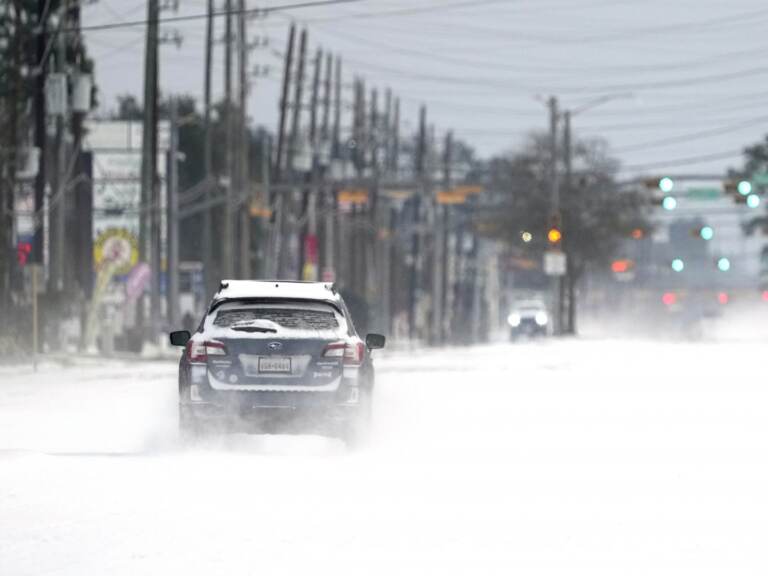Climate change in Pa.: More storm-driven power outages possible, analysis says
As climate change increases the chance of severe storms, outages could become more frequent if utilities don’t act to harden the electric grid.

Vehicles drive on snow and sleet covered roads Monday, Feb. 15, 2021, in Spring, Texas. A winter storm dropping snow and ice sent temperatures plunging across the southern Plains, prompting a power emergency in Texas a day after conditions canceled flights and impacted traffic across large swaths of the U.S. (David J. Phillip / AP Photo)
This story originally appeared on StateImpact Pennsylvania.
A new report shows extreme weather is responsible for most power outages across the country in the last two decades.
As climate change increases the chance of severe storms, outages could become more frequent if utilities don’t act to harden the electric grid.
The report from Climate Central found that 83 percent of reported outages between 2000 and 2021 happened because of weather events.
The group looked at more than 1,500 major outages reported to the federal government. A major outage affects at least 50,000 customers.
Pennsylvania ranked fifth in the country in weather-related outages, with 82 over the last 22 years.
Severe weather such as high winds, rain, and thunderstorms caused almost 6 in 10 weather-related outages.
Climate Central meteorologist Lauren Casey said a warming atmosphere becomes less stable, allowing thunderstorms to develop.
“We’re putting more moisture into the atmosphere as well, which can also serve to strengthen or sort of ‘kick off’ thunderstorm activity,” Casey said.
The report found winter weather, such as snow and ice storms, caused 22 percent of outages, while 15 percent were due to tropical storms and hurricanes. Extreme heat and wildfire made up about 5 percent of outages.
The analysis shows an increase in weather-related power disruptions over time, with more outages from 2011-2021 than in the preceding decade.
Casey said the report underscores the need for people to be prepared for outages with an emergency kit, and for utilities to harden the electric grid to withstand extreme weather.
Nils Hagen-Frederiksen, spokesman for the Pennsylvania Public Utility Commission, said the PUC closely monitors outages and reliability issues to identify areas of concern for individual utilities and statewide trends. He said the information is also used to help guide each utility’s long-term infrastructure improvement plan.
Hagen-Frederiksen noted trees are a big concern to utilities, especially ones growing outside utility right-of-ways but still close enough to power lines that downed limbs can disrupt electricity. He said the PUC is working with utilities to encourage greater collaboration between companies and private property owners.
The PUC’s 2020 Electric Reliability Report noted only 4 of 11 electric distribution companies in the state achieved the standard metric in all performance categories over a rolling 3-year average.
The federal Infrastructure Investment and Jobs Act passed last year gives more than $10 billion over five years to measures meant to help prevent outages and increase resilience for the nation’s electric grid.
WHYY is your source for fact-based, in-depth journalism and information. As a nonprofit organization, we rely on financial support from readers like you. Please give today.





